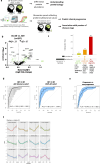CSF proteins of inflammation, proteolysis and lipid transport define preclinical AD and progression to AD dementia in cognitively unimpaired individuals
- PMID: 39523360
- PMCID: PMC11552178
- DOI: 10.1186/s13024-024-00767-z
CSF proteins of inflammation, proteolysis and lipid transport define preclinical AD and progression to AD dementia in cognitively unimpaired individuals
Abstract
This preclinical AD CSF proteome study identified a panel of 12-CSF markers detecting amyloid positivity and clinical progression to AD with high accuracy; some of these CSF proteins related to immune function, neurotrophic processes, energy metabolism and endolysosomal functioning (e.g., ITGB2, CLEC5A, IGFBP-1, CST3) changed before amyloid positivity is established.
© 2024. The Author(s).
Conflict of interest statement
Figures

References
Publication types
MeSH terms
Substances
Grants and funding
LinkOut - more resources
Full Text Sources
Medical
Miscellaneous

